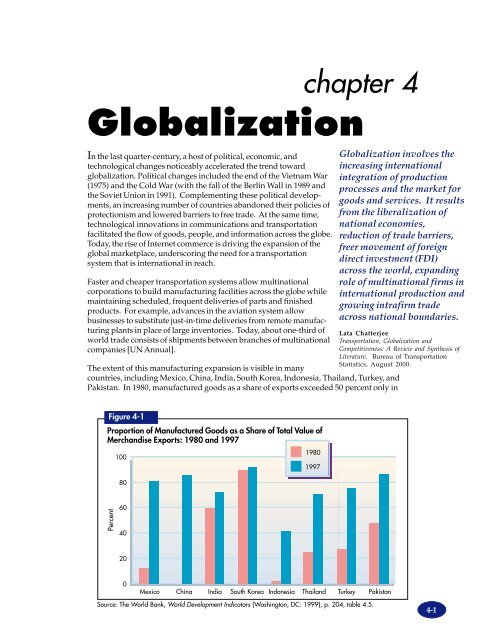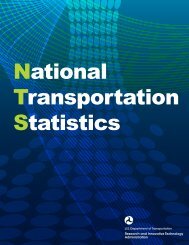- Page 1:
THE CHANGING FACE OF
- Page 4 and 5:
All material contained in this repo
- Page 6 and 7:
AcknowledgmentsU.S. Department of T
- Page 9 and 10:
Table of ContentsChapter 1—Vision
- Page 11:
Chapter 6—Technology ............
- Page 14 and 15:
change. Secretary Slater challenged
- Page 16 and 17:
A Chronology of Vision and Vigilanc
- Page 18 and 19:
January 1999New Rule Revising USDOT
- Page 20 and 21:
Table 1-1Forecasts Past and Future1
- Page 22 and 23:
Technology has played a critical ro
- Page 24 and 25:
Today, highway vehicle-miles travel
- Page 26 and 27:
conventional classroom with the adv
- Page 28 and 29:
than predicted. The large differenc
- Page 30 and 31:
In 1975, the nation saw nearly 50,0
- Page 32 and 33:
FAA and NASA: Working Together on A
- Page 34 and 35:
traffic and more time with families
- Page 36 and 37:
operations, maintenance, and mannin
- Page 38 and 39:
EnergyIn 1975, the United States co
- Page 40 and 41:
General Motors has manufacturing fa
- Page 42 and 43:
immigration and drug smuggling by s
- Page 44 and 45:
This report is organized around six
- Page 47:
chapter 2Growth, Deregulation,and I
- Page 50 and 51:
Figure 2-2Economic Growth in the Un
- Page 52 and 53:
Growth of the Transportation System
- Page 54 and 55:
Figure 2-6Vehicle-Miles Traveled on
- Page 56 and 57:
Box 2-1ISTEA/TEA-21The Intermodal S
- Page 58 and 59:
Box 2-3TelecommutingEmerging techno
- Page 60 and 61:
Figure 2-11Urban Rail Systems in th
- Page 62 and 63:
Figure 2-12Transit Ridership: 1975-
- Page 64 and 65:
the Gulf Coast Corridor, New York
- Page 66 and 67:
Air Traffic Performance-Based Organ
- Page 68 and 69:
Figure 2-17U.S. Domestic and Intern
- Page 70 and 71:
Box 2-6Higher Profits for U.S. Airl
- Page 72 and 73:
Figure 2-21Regional/Commuter Passen
- Page 74 and 75:
Figure 2-24Fixed-Wing Piston Aircra
- Page 76 and 77:
The FAA, in cooperationwith NASA, i
- Page 78 and 79:
LaunchesIn 1999, narrow-body aircra
- Page 80 and 81:
Millions of short tonsFigure 2-34U.
- Page 82 and 83:
Table 2-1U.S. Oceangoing Merchant M
- Page 84 and 85:
Figure 2-39Top 25 U.S. Container Po
- Page 86 and 87:
Figure 2-41U.S. Total Waterborne Co
- Page 88 and 89:
Significant deregulation legislatio
- Page 90 and 91:
the curtailed service in rural area
- Page 92 and 93:
Figure 2-45Railroad Network Showing
- Page 94 and 95:
direct flights to destinations and
- Page 96 and 97:
Figure 2-47International and Domest
- Page 98 and 99:
asis between shippers and carriers.
- Page 100 and 101:
Figure 2-48Total Ton-Miles of Freig
- Page 102 and 103:
Japan and Korea are still our major
- Page 104 and 105:
This shift from a “push” to a
- Page 106 and 107:
We may have to consider workforce-r
- Page 108 and 109:
Logistics Management and Distributi
- Page 111:
chapter 3Safety“ There is need fo
- Page 114 and 115:
Figure 3-1Total Fatalities in All M
- Page 116 and 117:
7. do a better job of data collecti
- Page 118 and 119:
The USDOT human factors research in
- Page 120 and 121:
Figure 3-4Total Traffic Fatalities:
- Page 122 and 123:
Vehicle Rollover and Size Compatibi
- Page 124 and 125:
Box 3-2Pedestrian and Bicycle Trips
- Page 126 and 127:
Figure 3-9Alcohol-Related Traffic F
- Page 128 and 129:
Under TEA-21, some portion of feder
- Page 130 and 131: Child Restraints: Standards for chi
- Page 132 and 133: Demographic Characteristics (age)In
- Page 134 and 135: Figure 3-18Crash Rate per 100,000 L
- Page 136 and 137: Road CharacteristicsSafer Roads: Si
- Page 138 and 139: Together, these systems provide an
- Page 140 and 141: Automation of enforcement efforts
- Page 142 and 143: By the mid-1980s, with deregulation
- Page 144 and 145: Transit SafetyIn 1975, transit, lik
- Page 146 and 147: Figure 3-28Total Train Incidents: 1
- Page 148 and 149: Figure 3-31Rail-Related Fatality Ra
- Page 150 and 151: Figure 3-34Number of Highway-Rail G
- Page 152 and 153: Figure 3-35Fatal Commercial Air Tra
- Page 154 and 155: In the early 1970s, the aviation in
- Page 156 and 157: The program was enhanced by an agre
- Page 158 and 159: Box 3-10 continued2,000 older, larg
- Page 160 and 161: Figure 3-41Recreational Boating Acc
- Page 162 and 163: systems for steering andmachinery m
- Page 164 and 165: In addition to search and rescue ac
- Page 166 and 167: communities with access to the info
- Page 168 and 169: are growing. Smart pigs will be inc
- Page 170 and 171: Regulations are issued by the USDOT
- Page 172 and 173: Keys to the FutureA number of curre
- Page 174 and 175: References23 CFR Part 1313. U.S. De
- Page 176 and 177: U.S. Department of Transportation (
- Page 178 and 179: _____. 2000c. Office of Investigati
- Page 182 and 183: India and South Korea, and were as
- Page 184 and 185: Table 4-1Top 10 U.S. Merchandise Tr
- Page 186 and 187: In 1975, the United States had four
- Page 188 and 189: Figure 4-5New Automobile Sales in t
- Page 190 and 191: the late 1990s, foreign minivans an
- Page 192 and 193: In 1975, only four U.S. carriers—
- Page 194 and 195: To overcome the barriers of nationa
- Page 196 and 197: Box 4-5“Open Skies” Bilateral a
- Page 198 and 199: Figure 4-10International Aviation L
- Page 200 and 201: Box 4-7International Aviation Safet
- Page 202 and 203: Table 4-7 4-1Top 10 Shipments by Ai
- Page 204 and 205: Express services continue to grow a
- Page 206 and 207: Figure 4-17U.S. Share of World Ship
- Page 208 and 209: Figure 4-20Country Shares of World
- Page 210 and 211: involving ships whose safety is ove
- Page 212 and 213: Figure 4-24Merchandise Exports to M
- Page 214 and 215: Figure 4-27Merchandise Imports from
- Page 216 and 217: In the United States, traditional t
- Page 218 and 219: Colography Group Inc. 1999. The Col
- Page 220 and 221: Tagliabue, J. 2000. Volvo To Buy Re
- Page 223: chapter 5People, Energy, andthe Env
- Page 226 and 227: enhances the environment through se
- Page 228 and 229: oomers, as children, dominated the
- Page 230 and 231:
Table 5-3Licensing by Race/Ethnicit
- Page 232 and 233:
Figure 5-7The improved longevity of
- Page 234 and 235:
Figure 5-9suburbs, forcing many cen
- Page 236 and 237:
Long-Distance Travel: Initiated for
- Page 238 and 239:
Figure 5-14Vehicle Use by Distance
- Page 240 and 241:
Income also has a major impact on t
- Page 242 and 243:
The USDOT’s mobility goals are di
- Page 244 and 245:
Table 5-4Transportation Energy Use
- Page 246 and 247:
Figure 5-23The continuing growth of
- Page 248 and 249:
in 1990 to 105 trillion in 2050. In
- Page 250 and 251:
these impacts are not fairly distri
- Page 252 and 253:
acceptable ranges for some fuel qua
- Page 254 and 255:
Index, 1975=1.0Index, 1975=1.0Figur
- Page 256 and 257:
Box 5-7 continuedTransportation Dem
- Page 258 and 259:
diseases such as malaria. Moreover,
- Page 260 and 261:
1. policies should be guided by sci
- Page 262 and 263:
Moreover, transportation infrastruc
- Page 264 and 265:
alternate response technologies inc
- Page 266 and 267:
Figure 5-30Transportation Noise Lev
- Page 268 and 269:
approach and 6,500 meters on takeof
- Page 270 and 271:
landfills, or it can be dumped in c
- Page 272 and 273:
Moreover, the role of transportatio
- Page 274 and 275:
ReferencesAmerican Petroleum Instit
- Page 276 and 277:
_____. 2000. Employment Status of t
- Page 279:
chapter 6Technology“Just as in th
- Page 282 and 283:
einforce older structures. New kind
- Page 284 and 285:
Figure 6-1Nationwide Differential G
- Page 286 and 287:
Box 6-1Free FlightPilots today pick
- Page 288 and 289:
primarily invested in Freeway Manag
- Page 290 and 291:
Table 6-1Metropolitan Intelligent T
- Page 292 and 293:
Source: U.S. Department of Transpor
- Page 294 and 295:
Washington State Department of Tran
- Page 296 and 297:
information services will be integr
- Page 298 and 299:
The federally funded Northeast Corr
- Page 300 and 301:
The 1990s also saw a renaissance of
- Page 302 and 303:
typical, state-of-the-art rail safe
- Page 304 and 305:
Aviation TechnologyThe U.S. Nationa
- Page 306 and 307:
Box 6-8Communication TechnologiesIn
- Page 308 and 309:
Box 6-11Weather Information Technol
- Page 310 and 311:
Box 6-13Future Aviation Technologie
- Page 312 and 313:
Avionics: Avionics is the use of sa
- Page 314 and 315:
among the various modes of transpor
- Page 316 and 317:
Maritime safety continues to be a h
- Page 318 and 319:
U.S. Department of Commerce (USDOC)
- Page 321 and 322:
chapter 7National SecurityTransport
- Page 323 and 324:
Table 7-1Maritime Security Program
- Page 325 and 326:
(channel maintenance and wreck remo
- Page 327 and 328:
Figure 7-3The Strategic Highway Net
- Page 329 and 330:
Figure 7-6Worldwide International T
- Page 331 and 332:
Figure 7-11Worldwide Incidents of P
- Page 333 and 334:
Box 7-1The Y2K ChallengeThe Y2K pro
- Page 335 and 336:
Threats to Aviation SecurityThe eme
- Page 337 and 338:
Require certification of security s
- Page 339 and 340:
Box 7-3 continuedSeptember 5, 1986:
- Page 341 and 342:
Box 7-4U.S. Coast GuardLocated with
- Page 343 and 344:
Administration, U.S. Department of
- Page 345 and 346:
PageFigure 2-1 U.S. Population: l97
- Page 347 and 348:
Figure 3-32 Grade-Crossing Fatality
- Page 349:
Figure 7-5 Worldwide Casualties Due
- Page 352 and 353:
CRAFCivil Reserve Air FleetCVOComme
- Page 354 and 355:
PPPsPTCPTPR&DRNAVRPMRRFRRIFRSPARTMs
- Page 356 and 357:
Bilateral Agreement: A concurrence
- Page 358 and 359:
Dynamic routing: In demand-response
- Page 360 and 361:
Intercity rail system: Transportati
- Page 362 and 363:
Pedalcyclists: A person on a vehicl
- Page 364 and 365:
Tractor-trailer: Tractor and semitr
















